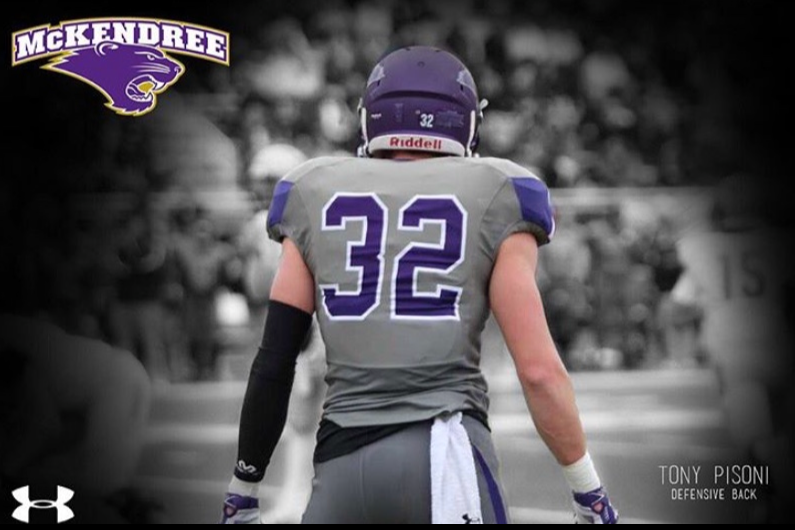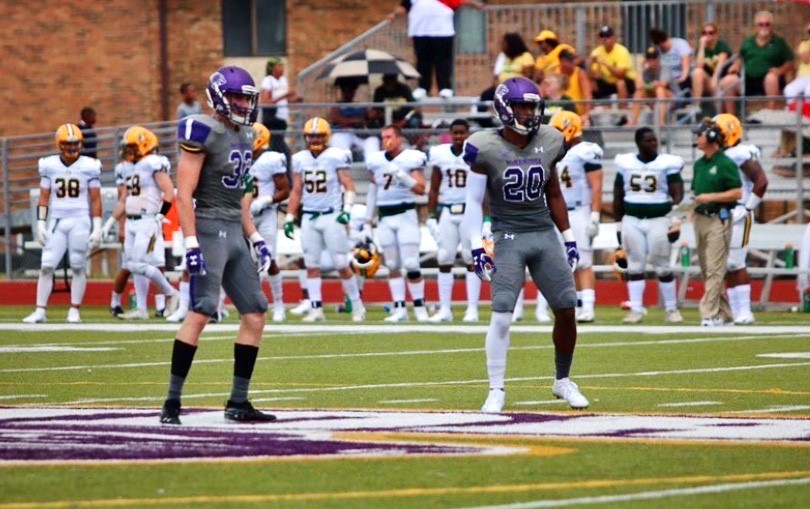
By Paris Suzuki, contributing writer
Photos by McKendree Athletic Department
March 20, 2019 would change the football career of McKendree University’s sophomore cornerback, number 32, Tony Pisoni. Headed into the spring season with junior year approaching, Pisoni was listed as a player to watch out for.
“Pisoni is going to go crazy and be undefeatable this year,” players would say.
His hard work and dedication during the off-season paid off and it was now his time to shine.
Pisoni was covering a wide receiver during spring ball practice for the Bearcats. The receiver was running a dig route, an offensive play where the receiver runs 10 yards forward and then makes a 90-degree cut to the inside. When the receiver caught the pass from the quarterback, Pisoni was on the backside, pulling him to the ground.
“I put my hand on his hip and spun him away so he couldn’t catch control of it,” said Pisoni.
He pulled the receiver to the ground and his ankle got caught between the other player’s feet.
“I felt it pop one way and then when I hit the ground, felt another pop,” Pisoni said. “As I was on the ground, I thought, well this sure isn’t good, and when I looked down, my ankle was the size of a softball.”
He was then taken out in the ambulance and the ankle would be diagnosed as broken. Plates, rods, and screws would now be part of the anatomical makeup of Tony Pisoni. He questioned even coming back to McKendree after the injury. His whole football career had ended within a 10 second play at one single practice.
This is just one example of athletes training extremely hard and putting so much time and dedication into their sport with the risk of being injured. Injuries become traumatic experiences for athletes since they develop their whole life around their sport. It can all suddenly be taken away in a span of seconds during just one play.
Pisoni would no longer be on the field doing ball drills and running routes, but instead, he would be in the Athletic Training room, undergoing physical therapy, attempting to wiggle his toes, and moving marbles from one bowl to another.
“I think it was more for myself,” Pisoni said. “I basically wanted to see if I could play football again. If I wanted to play football again, I would have to go through physical therapy to build up trust in my ankle.”
He stated that it was more of a challenge for him to overcome this traumatic life-changing event which, in the end, motivated him to continue on. Physical therapy is all about patience and a slow healing process. Many athletes have a hard time completing this process from the desire to recover immediately and get back to playing their sport. Pisoni was no exception.

When asked if there were times during this process that he wanted to give up, Pisoni immediately confirmed.
“Oh, every day,” Pisoni said. “I thought to myself, ‘this is stupid, it’s not worth it.’ It was so tedious and boring. I didn’t understand why I had to wiggle my toes and couldn’t do challenging activities.”
Oftentimes, he would get very frustrated because these simple tasks that he used to think were so small, he could no longer perform.
“As physical therapy continued, it got harder, but it wasn’t too hard to the point where I wanted to give up,” Pisoni said. “It pushed me to find my limits. The first question I asked was, when am I going to be back?”
Pisoni stated that going back to school was a difficult adjustment for him.
“Returning to the classroom was awkward,” Pisoni said. “All the heads in the room would turn and everyone would ask what happened to me. I would just constantly be bombarded with questions.”
He did not want to be looked at with pity, and it felt like everyone around him was feeling bad for him. It drew negative attention toward him, which did not necessarily help with his recovery process.
“I got a scooter though!” Pisoni joked. “I was just wheeling around everywhere! It was even personalized, I put a little bell on it, ding ding!”
Something as little as a bell brightened up Tony’s perspective in a tough time and kept him laughing throughout the day. He turned a negative into a positive, which is just the type of person he is.
Keeping up with the assignments and schoolwork was difficult for him at first since he had a lot less motivation and a lot more schoolwork. There was a lot going on during this time of his life, but in the end, he achieved the highest-grade point average he has ever had. Going to practices, film, meetings and games were especially hard for him.
“I would just sit there and watch everyone,” Pisoni said. “I would learn all the plays and then I would just sit there for two hours having the sun just beating on me as I was standing on my crutches or sitting on my scooter.”
Sometimes he just wanted to lay in bed or not go at all because he did not feel like there was any point. It almost felt as though it was a waste of time to him because he did not feel essential. It took a toll on his emotions since he had nothing to do but stand on the sidelines, which tested his motivation and patience.
Through his physical therapy process, he had a solid support system. Pisoni is one of nine children, so he had plenty of support from his family emotionally and mentally. At school, his friends showed him the in-person support he needed since his family could not visit all the time.
“My friends would constantly check up on me and know when I was down,” Pisoni said. “They offered support for me when I was feeling down and could tell when I needed something.”
His position coach would text him weekly checking in for a progress report on how he was feeling, physically, emotionally, and mentally.
Physical therapy was supposed to be over for him in August when he returned for the fall semester, however, his bones were not healing correctly.
“The doctor reviewed my ankle and said that it looked like I jumped off a twenty-story building and landed directly on my ankle,” Pisoni said.
Even though he was working hard during his therapy and through the summer, he would now have to double the work and do it during the season he was supposed to be playing in. Come spring ball in 2020, a whole year later, Pisoni was stoked to come back on the field after finally being cleared by the athletic trainer. Teammates and coaches began to start posting on their social media, welcoming Pisoni back on the team since they had been waiting on his return. Though he was back and cleared, the coaches were looking out for him and would pull him from drills.
“It was kind of annoying because they were almost babying me, but I definitely understand why they did, ‘cause they care,” Pisoni said. “I just wanted to be back to where I was.”
Once the third spring practice came around, they saw that he put in work and knew his limits while maintaining the drive he had before. However, Pisoni still had a million questions running through his head while he was making the transition from therapy to the field.
“Would I be able to fully recover?” Pisoni said. “Will it happen again? Will I be the player I was or am I going to just be a bad player?”
Fear is a common emotion that injured athletes have during their recovery process and even in furthering their play.
“I am confident in myself to do everything,” Pisoni said. “Even though I may have lost a step or two, I know and am confident that I can do it and do it just as good as I did before.”
Even though he has been 100% cleared, there is still a fear of rebreaking it. At first, this made him nervous when he was getting back into training and lifting.
“I was scared to squat over like 225lb because I didn’t know how my ankle was going to hold up,” Pisoni said.
One day, he thought that he might as well try to add weight by putting on a 10lb plate since he was at this weight for a week and needed to push himself. He succeeded.
“This allowed me to continue to push myself and do more,” Pisoni said. “I know it sounds cliché, but it was like everyone was rooting for me. Every time I would be in PT or the weight room, the boys would come see me and be like, ‘Yeaaaahh Pisoni! Time to get back right!’ and it would make me crack up, but I knew they were all excited for me to come back.”
Tony Pisoni had a major injury in the spring of 2019. He started his recovery by trying to wiggle his toes and it took him out of the sport he grew up playing for a whole year. Though this was not ideal, he was thrilled to be supported by his community through this time of need. Pisoni’s path to play showed his leadership, grit and dedication. He is now back on the field, and he is a player that opponent coaches remind their own players to watch out for. Due to his character during his recovery, he became a respected player his teammates look up to and his coaches rely on, on and off the field.

“To anyone out there going through a sports injury, I would say to trust yourself and keep pushing yourself to keep going,” Pisoni said. “You don’t want to just give it up after injuring yourself one time. Obviously, there are certain circumstances, but I wasn’t expected to ever be able to run again. I didn’t think I was ever going to. I had that support. I constantly kept pushing. I didn’t give up, and now I’m on the field again.”
What an inspiring story! Thanks for sharing, Paris, and congrats to Tony for persevering through such a tough challenge.
What an inspirational, well-written article!!
Great, insightful, firsthand look at an athletes road from sudden trauma, to inspirational recovery.
Great article! I had fun being interviewed and would really like to thank you for writing this.
Amazing! Great insight of an inspirational story P.
Awesome article. Pisoni, way to persevere through all obstacles.
Love you mucho, Tony! You are an inspiration to us all – can’t wait to see you back in action soon. I am lucky to be your prof. Thanks for shining a light on Tony’s perseverance and commitment, Paris <3
Photographed Tony for our local newspaper in Jefferson County, Mo. I’m not surprised at all to read about his drive to get back. He comes from a great family and he was coached well in high school. Great job Tony & great article!